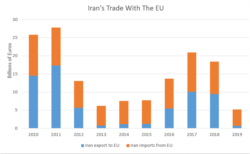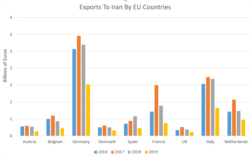As Britain, France, and Germany finally on Tuesday managed to conclude Europe's first humanitarian goods transaction with the Islamic Republic under U.S. sanctions, the latest data show a significant drop in trade with Iran.
A European Commission report published last Tuesday shows that the value of products the 28 EU members exported to Iran in 2019 dropped fifty percent, compared with the previous year.
Meanwhile, EU's imports from Iran in the same period show a fourteen-fold decrease. Before U.S. sanctions the bulk of Europe’s imports from Iran was oil.
In 2019, the EU exported $4.9 billion of products to Iran, and only imported $761 million of goods from the Islamic Republic. The figure is the lowest since the Islamic Republic was founded in Iran, more than four decades ago (1979).
Washington withdrew from the Joint Comprehensive Plan of Action (JCPOA) or Tehran nuclear deal with world powers in May 2018. It also imposed paralyzing sanctions on the Islamic Republic's already ailing economy.
Therefore, Iran's exports to Europe dropped from more than ten billion euros ($10.9 billion) in 2017 to 9.5 billion euros ($10.3 billion) in 2018, and only 700 million euros ($766 million) last year.
During international sanctions (2012-16), Europe refused to buy Iranian crude oil. Still, its imports from Iran never dropped as it did last year. Therefore, one can conclude that the volume of non-oil Iranian products exported to Europe has also shrunk.
Besides products, Europe has also had service exports to Iran. However, the 2019 data related to it has not been published so far.
Service exports are a significant emerging trend in global trade. Many traditional manufactured product exports increasingly contain technology that requires installation, troubleshooting, maintenance, and repairs.
EU's service exports to Iran in 2018 amounted to nearly 1.57 billion euros ($1.7 billion), more than fifteen percent less than the previous year.
Data provided by the European Commission also show that, with more than 1.5 billion euros ($1.64 billion), Germany was the top European exporter to Iran. The figure also indicates that, compared with 2018, Germany's exports almost halved in 2019.
One step behind Germany, was Italy with 824 million euros ($921 million) of exports. Italy's export to Iran also halved compared with 2018.
In the meantime, Germany and Italy were the main European destinations for Iranian goods.
Following Washington's withdrawal from the JCPOA in 2018, the Islamic Republic had insisted on launching a European financial system to help Tehran continue its transactions with the EU. Without such a system, the Islamic Republic had threatened a gradual withdrawal from JCPOA.
To satisfy Iran's demands, Britain, France, and Germany conceived a complex barter-type system, the Instrument in Support of Trade Exchanges dubbed as INSTEX. Its mission is to facilitate non-USD and non-SWIFT transactions with Tehran to avoid breaking U.S. sanctions imposed on the Islamic Republic.
So far, INSTEX has been used just once to sell humanitarian goods to Iran. Washington maintains food and medical supplies are excluded from its sanctions.
Nonetheless, it is not yet clear how INSTEX could significantly increase EU's exports to Iran. However, as Washington has sanctioned buying crude oil from Iran, a substantial increase in the Islamic Republic exports to the EU is highly unlikely.








